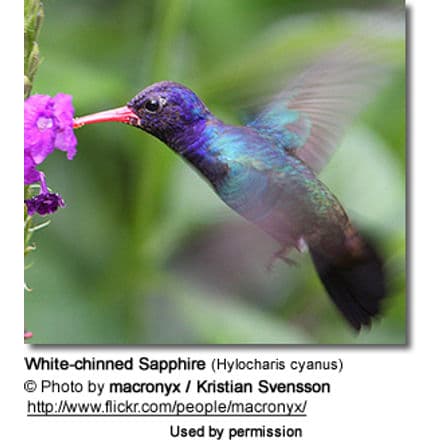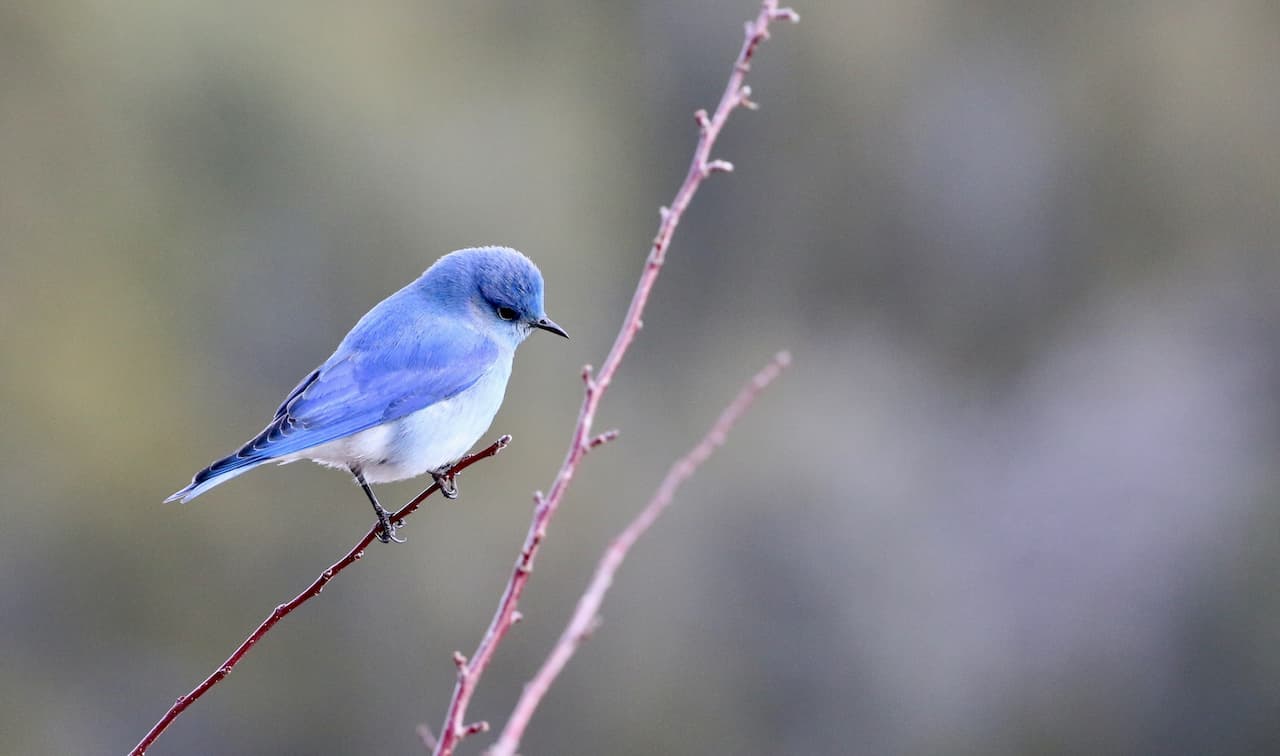White-chinned Sapphires
The White-chinned Sapphire (Hylocharis cyanus) is a South American hummingbird species that is found in Argentina, Bolivia, Brazil, Colombia, Ecuador, French Guiana, Guyana, Peru, Suriname, and Venezuela, where it is mostly sedentary (non-migratory).
They occur in gallery and white-sand forests, restinga (Brazilian coastal tropical and subtropical moist broadleaf forest), and along the forest edges. They are not common in cities.
Description:
The White-chinned Sapphire Hummingbird averages 8 – 9 cm in size (from the top of the head to the tip of the tail).
It has a straight red bill with a black tip; as well as a dark blue forehead, crown, cheeks, and throat. The rump is coppery-colored and the flanks are green. It has been named for its white-feathered chin.
Subspecies, Ranges, and ID
- Hylocharis cyanus cyanus (Vieillot, 1818) – Nominate Race
- Range: Coastal eastern Brazil (Pernambuco to Rio de Janeiro).
Hylocharis cyanus conversa (Zimmer, 1950)- Range: Eastern Bolivia, northern Paraguay, and southwestern Brazil (Mato Grosso do Sul).
- Hylocharis cyanus griseiventris (Grantsau, 1988)
- Range: Coastal southeastern Brazil (São Paulo) and northeastern Argentina (Buenos Aires)
- ID: Can be differentiated from the other subspecies (including nominate) by its greyish abdomen. All the others have a green abdomen.
- Hylocharis cyanus rostrata (Boucard, 1895)
- Range: Eastern Peru, northeastern Bolivia, and western Brazil (Mato Grosso). They are also likely to occur in eastern Ecuador.
- Hylocharis cyanus viridiventris ( Berlepsch, 1880)
- Range: Northern and eastern parts of Colombia, western and southern Venezuela, and the Guianas to northern Brazil (Mato Grosso and Maranhão).

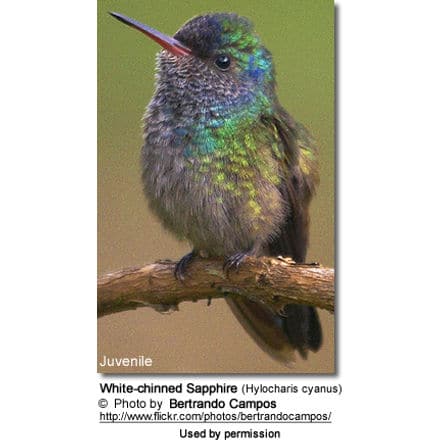
Alternate (Global) Names
Czech: Kolibrík belobradý, kolib?ík b?lobradý … Danish: Blåbrystet Safir … Dutch: Witkinsaffierkolibrie, Witkin-saffierkolibrie … German: Weißkinnsaphir, Weisskinn-Saphir, Weißkinn-Saphirkolibri … Spanish: Picaflor lazulita, Zafiro de Cabeza Azul, Zafiro Gorgiblanco … Finnish: Sinisafiirikolibri … French: Saphir azuré … Guarani: Mainumby … Italian: Colibrì zaffiro golabianca, Zaffiro mentobianco … Japanese: shiroagosafaiahachidori … Norwegian: Hvithakekolibri … Polish: szafirek bialobrody, szafirek bia?obrody … Portuguese: Beija-flor-rojo, beija-flor-roxo … Russian: ?????????? ?????? … Slovak: kolibrík bielobradý … Swedish: Blåbröstad safir
Nesting / Breeding
Hummingbirds are solitary in all aspects of life other than breeding, and the male’s only involvement in the reproductive process is the actual mating with the female. They neither live nor migrate in flocks, and there is no pair bond for this species. Males court females by flying in a U-shaped pattern in front of them. He will separate from the female immediately after copulation. One male may mate with several females. In all likelihood, the female will also mate with several males. The males do not participate in choosing the nest location, building the nest, or raising the chicks.
The female White-chinned Sapphire is responsible for building the cup-shaped nest out of plant fibers woven together and green moss on the outside for camouflage in a protected location in a shrub, bush, or tree about 1 – 4 m (3 – 13 feet) above the ground. She lines the nest with soft plant fibers, animal hair, and feathers down, and strengthens the structure with spider webbing and other sticky material, giving it an elastic quality to allow it to stretch to double its size as the chicks grow and need more room. The nest is typically found on a low, thin horizontal branch.
The average clutch consists of two white eggs (1 – 3 are possible), which she incubates alone for 14 – 15 days, while the male defends his territory and the flowers he feeds on. The young are born blind, immobile, and without any down. They leave the nest (fledge) when they are about 20 – 26 days old.
The female alone protects and feeds the chicks with regurgitated food (mostly partially digested insects since nectar is an insufficient source of protein for the growing chicks). The female pushes the food down the chicks’ throats with her long bill directly into their stomachs.
As is the case with other hummingbird species, the chicks are brooded only the first week or two and are left alone even on cooler nights after about 12 days – probably due to the small nest size. The chicks leave the nest when they are about 20 days old.
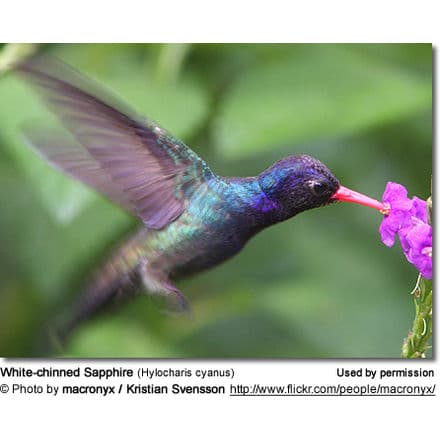
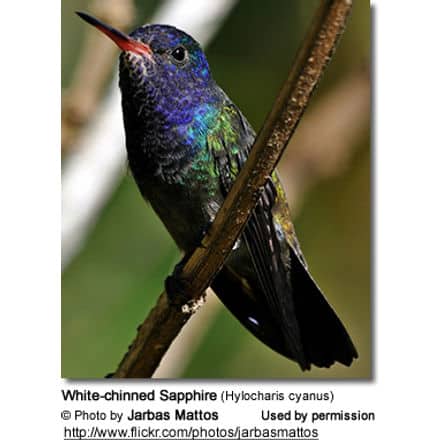
Diet / Feeding
The White-chinned Sapphire Hummingbirds primarily feed on nectar taken from a variety of brightly colored, scented small flowers of trees, herbs, shrubs, and epiphytes.
Hummingbird Resources
- Hummingbird Information
- Hummingbird Amazing Facts
- Attracting Hummingbirds to Your Garden
- Hummingbird Species
- Feeding Hummingbirds

